投稿日:
更新日:
Nagano New life born from: Innovators of traditional crafts
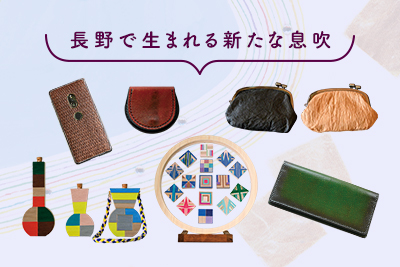
Traditional crafts can be said to be symbolic of Japanese handicrafts and aesthetic sense. Nagano However, various techniques have been refined, loved, and have been close to life, and have coloured my life. However, the reality is that due to changes in lifestyle, many have become "old-fashioned" things that are a little bit distant from everyday life.
Did you know that crafts that combine new techniques and sensibilities have been created to resist this trend? With this in mind, "I want beautiful traditions to be familiar with everyday life," we would like to introduce innovators who break the preconceived notions and breathe new life into them.
Iida Mizuhiki's future shape, united like art
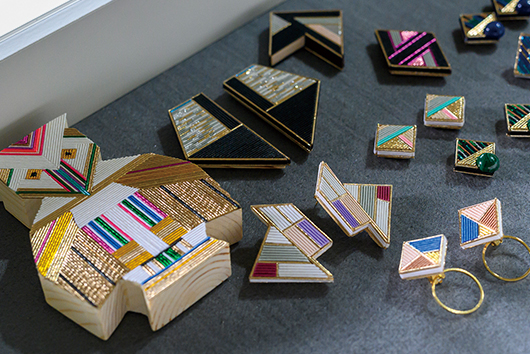
RITUAL the crafts
Nakata Shingo
Nakata Shingo works in jewelry and art works using Iida Mizuhiki, a local industry that boasts a nationwide share of approximately 70%. The biggest feature is the use of the unique shape of a mizuhiki, a string, and the texture of a washi paper, and the expression of an expression using mizuhiki like drawing, not bound by the traditional method of "tiing." Many people first come to see the bright colors and the intense impact of delicate and innovative designs, and then they are surprised twice: they are surprised by the first time they see it, and when they find out that the material is Mizuhiki, they are surprised again.
Nakata was born in Iida City, graduated from an art university in Tokyo, and worked on prints and paintings. When he returned home in 2016 and casually arranged Mizuhiki, which you can get close to, he felt the possibility of something new.
"I wanted to create something new with Mizuhiki, a traditional industry that the locals boasts of. I was used to seeing a variety of things as materials from my experience in art production, so I thought I could take a different approach than before."
That was the reason why the work was born. His wife Naomi's idea of "How about making jewelry?" has been pushed into commercialization, and recently he has been receiving calls from department stores and other department stores, expanding his activities all over the country.
"My approach may not be called traditional crafts, but I would be happy if the tradition and values of Iida Mizuhiki will be rethinked through our activities and works. I hope that while also cherishing Mizuhiki's culture of "tiling" and that by creating a soil where various artists, like me, can be created based on their individual senses, I hope that they will be involved in creating a prosperous soil in which the existence of Mizuhiki itself will grow."
Nakata says this. By making the most of the sensibilities that only artists can create, we open up new possibilities for Mizuhiki.
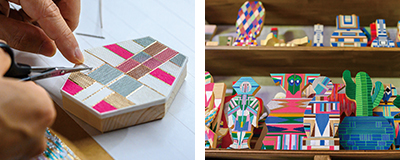
Nakata renovated the tenement house in the house where my grandmother lives and turned it into a workshop. He doesn't do rough sketches, but instead sticks a mizuhiki onto the base of a piece of wood he cut himself, and tries out the color combinations over and over again. Recently, the range of works has expanded, such as combining them with metal. A solo exhibition will be held at the Unformel Nakagawa Village Museum of Art from July 27th to September 1st.
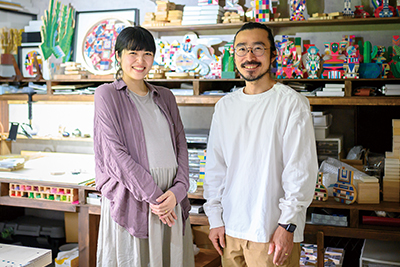
Naomi, who is in charge of designing packaging, apparently initially worried that it would fall outside the framework of Mizuhiki's tradition, but after learning about the history of Mizuhiki's meaning and use that have changed over time, she feels that "the current style may be one of the changes."
[RITUAL the crafts]
https://www.ritual-dolmen.com/
INFORMATION Ginza NAGANO But we will handle some products
An unknown realm of lacquer and leather opened up by a passion for evolution
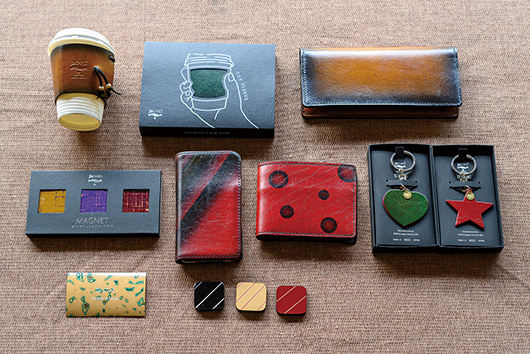
Miku Urushi Crafts
Iwahara Yuuu(Shiojiri City)
Lacquer crafts were once described as "japan" in English. Kiso lacquerware, one of Japan's leading traditional crafts, gained popularity as a souvenir for travelers on the Nakasendo road during the Edo period, and during the period of high economic growth in the Showa era, zakutaku became an essential item for homes and inns. Currently, the company is involved in the restoration of cultural assets as a production area, mainly at the Shiojiri and Kiso Regional Local Industry Promotion Center, and is carrying out lacquer painting for the restoration of Ueno Toshogu Shrine and Nagoya Castle Honmaru Goten, making use of traditional techniques, and is being passed down to the next generation.
Iwahara Yuu is one of the successors who worked in manufacturing in other industries and began working in the lacquer-painting family business that has been around since his grandfather's generation. However, in 2012, we wanted to create things that only we could and what we wanted, so we launched our own workshop, "Miku Urushi Kogei," in a bid tone with the family business.
Lacquer has a strong image of tableware and decoration, but with the idea that if it could carry it around on a daily basis, there would be more demands and interest in young people, it was launched with the idea that it would attract more interest to young people. The development of unique items that can be used everyday has received high praise, and in 2016, the company announced the "LEXUS NEW TAKUMI PROJECT 2016" Nagano Selected as representative. Furthermore, the same year's "ShinshuHe was also selected for the Brand Awards 2016.
The true essence of "jaCHRO" is "jaCHRO leather", which is made by lacquer on leather. The lacquer isTimesBecause the product hardens by applying it to a soft product like leather, it usually causes cracks, but after several years of trial and error, Iwahara has successfully reduced the cracks through special processing. Lacquer applied to leatherTimesWith each pursuit, the depth increases and it shows a unique presence.
Iwahara also collaborated with CYPRIS, one of Japan's leading leather brands, and in February this year, he became completely independent and made a new start as a lacquer craftsman. We are even more excited about what possibilities and what products our activities pursuing "unprecedented lacquer products" will create.
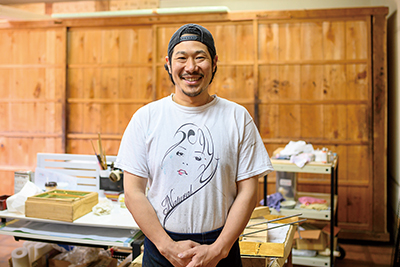
Miku Urushi Kogei is located in Kiso Hirasawa, Shiojiri City, the central production area of Kiso lacquerware. After getting a job at a construction company, Iwahara became a big fan of motorcycles and worked in a variety of manufacturing jobs, including manufacturing and selling leatherwork and silver accessories, and metal processing. This was used in the development of "jaCHRO leather" in 2015. Incidentally, "jaCHRO" is named by combining Japan (lacquer) and Chromatics (colors). The first product was a packaged magnet.
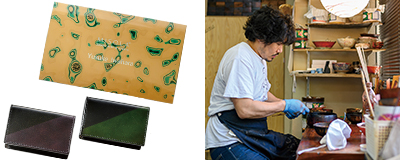
At "LEXUS NEW TAKUMI PROJECT 2016," we created a business card using Kiso Yozuka, a typical Kiso lacquerware technique. It is difficult to apply lacquer on thin materials, and the wood itself warped due to the temperature and humidity, which was a pain. It is said that there are still many exchanges with the masters from all over the country whom I met during the project, giving advice to each other.
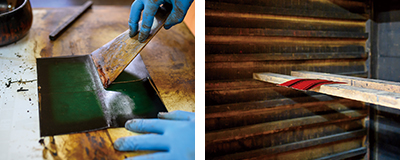
Because temperature and humidity control greatly affect the performance, lacquer is applied slowly in a drying room called a moro. "jaCHRO leather" is made over a month using the technique called "suri lacquer," which involves applying raw lacquer and wiping it over and over again.その分、色合いに独特の奥行きが生まれ、TimesIt becomes vibrant and develops gloss as you use it.
[Miku Urushi Crafts]
Nagano 1905-7 Kiso Hirasawa, Shiojiri City, Prefecture TEL 0264-34-2644
INFORMATION Ginza NAGANO But we will handle some products
The new value of Uchiyama paper given to us by good old wisdom
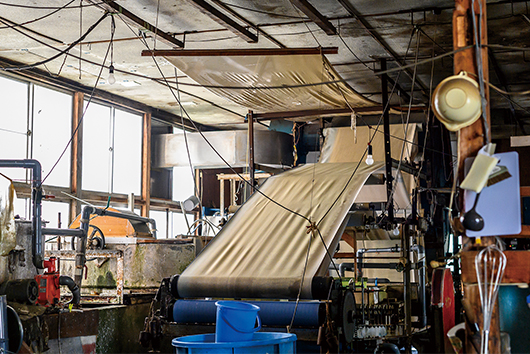
Abe Paper
Abe Takuya(Iiyama City)
Heavy snow areaIiyama CityUchiyamagami, a supple and strong Japanese paper, is made by bleaching the bark of Kozo, the raw material, using a unique technique that makes use of the environment of the product, using snow exposure. Abe Takuya, the third generation of Abe Paper, who began his career as a craftsman at the age of 20 and was 33 years old, was certified as a traditional Uchiyama Paper Craftsman in 2010, was influenced by the Uchiyama Paper Paper Coyori, which was released as a belonging to his grandmother. "My grandmother made vests and ties out of paper shading. I made a variety of things with Uchiyama paper, including accessories and objects," he recalls.
Once again, Abe realized the possibilities and diversity of Uchiyama Paper, and began making small items such as business card holders using paper shading. Their activities were recognized, and in 2018, they were awarded the "LEXUS NEW TAKUMI PROJECT 2018" Nagano He was selected as a representative of the prefecture. This was the opportunity to complete a clutch bag made of paper shingles. The paper shingle material is made from the Iida Mizuhiki Factory, which is gently twisted to the limit, creating a soft texture unique to Uchiyama Paper. Furthermore, we have introduced large looms to improve and stabilize quality, and weaving techniques from our friend Ueda Tsumugi craftsmen, creating masterpieces that make use of the techniques of traditional crafts from other regions.
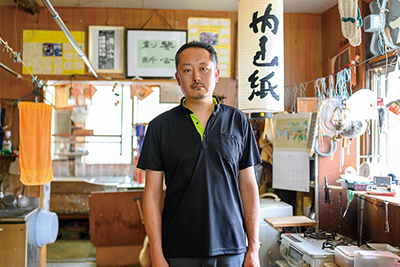
"Every time weaving paper shingles, you can find different challenges, so we haven't made anything that will satisfy us yet, but it's the most interesting thing when you're trying something new."
What drives Abe to say this is his pure desire as a craftsman to help more people know about the charm of Uchiyama Paper.
"Originally, what I should do is not creative work, but papermaking. I'm doing my production activities because I want to convey the possibilities of Uchiyama Paper to people in various industries and creators. I want to increase the number of people who want to try it out."
Abe is currently working on developing a product collaboration with craftsmen from other prefectures. It is scheduled to be announced soon, and his eyes are shining, saying, "I'm happy that a new use of Uchiyama paper will be created."
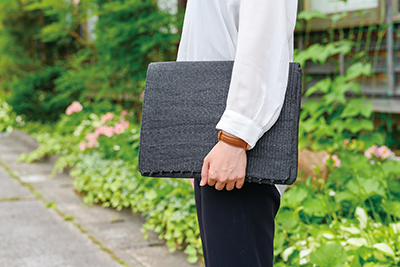
A clutch bag made from Uchiyama Paper paper, known as high-quality shoji paper because it is durable, long-lasting, and does not easily discolor, using both warp and weft threads. The stitching is finished by hand stitching so that the tightening level can be adjusted with the amount of force. Changing the color, thickness of the paper shingle and how it is twill creates a different atmosphere. Currently, only made-to-order products are available.
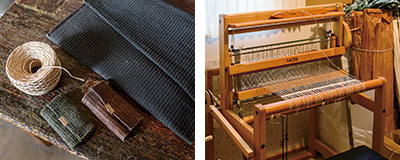
Small items such as key cases have been made from a small loom that I used to own, and all of the items in the photo on the left are Abe's personal items. The one on the left has been in use for 10 years, and since it was washed twice in the past, it has been proven to be somewhat water resistant. "The happiest thing I've ever had was that someone bought me a key case as a gift for my father to retire," says Abe. The photo on the right shows a newly introduced large loom.
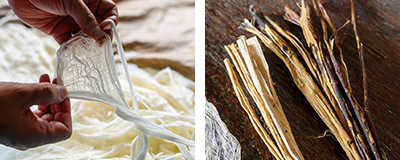
Uchiyama paper is created by finely chopped kozo bark fibers that look like gauze at first glance. The photo on the right shows the kozo before and after exposure to snow, and can be seen to be quite bleached by snow exposure.
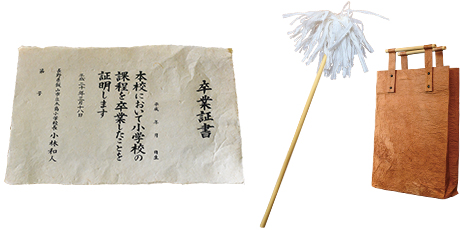
Abe Paper has been working together to create graduation certificates for local elementary schools for about 30 years, and elementary school students are apparently doing everything themselves, from cultivating kozo to making paper.
We also have the opportunity to reuse the kozo tree part, which was previously thrown away, and we have also created Uchiyama paper stripes and bags with wood used for the handle.
[Abe Paper]
Nagano prefectureIiyama CityMizuho 4894 TEL 0269-65-2594
http://www.uchiyama-gami.jp/
This article is information as of July 2019.
Please note that the products we carry may have changed.















